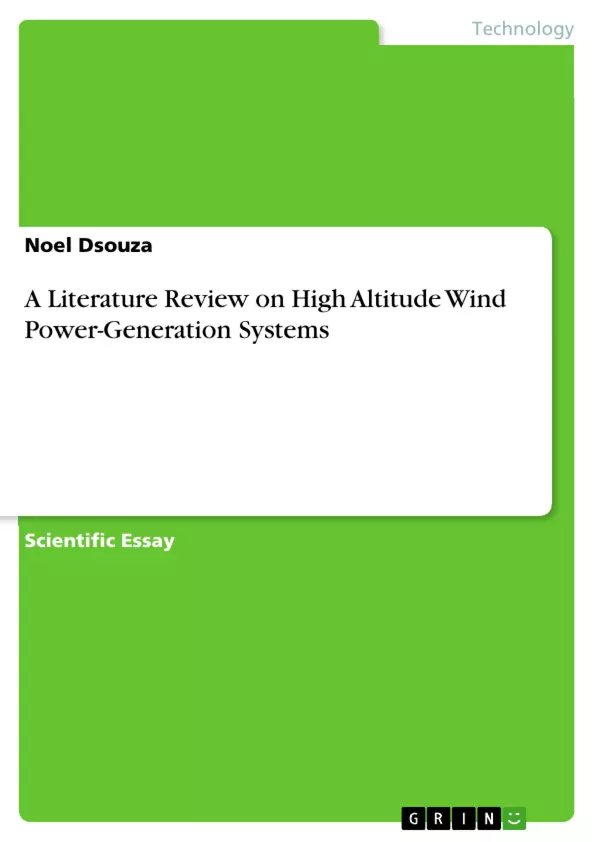There has been rising popularity with Alternate Energy Sources, in the past few decades with the Global Energy Demand and Supply Situation being brought into the spotlight. Although in a recent article published by the International Renewable Energy
Agency (IRENA) [1] , future estimates of renewable energy contribution stands at Hydroelectric power leading the way with a 17% contribution to World Renewable Energy Consumption, Wind Power lags not too far behind at 14% contribution to Global Renewable Energy. Wind Power is primarily supplied through the use of Horizontal Axis Wind Turbines, among which the 3-blade design is the most frequently used. Although the wind turbine holds the rank of the most commonly used method, many studies show that higher wind speeds exist at altitudes above the reach of current wind turbines.
This report aims to take a further look into this, by studying various papers and journals on this subject along with the correlation of wind speeds to different altitudes on the Earth’s surface, and by looking into the various High Altitude Wind Energy Systems particularly, the Kite system which is the most successful till date. Also, the general wind speed distributions all over the world using the Weibull Parameters are looked into briefly.
The design considerations an fluid modelling of a curved airfoil used in typical kite power system is analysed. Finally, a brief cost analysis on existing wind turbine technology with kite power systems is undertaken. A list of references at the end of the report establishes the sources and citations regarding this report and also gives credit to the various papers and journals used for the compilation of this work.
Inhaltsverzeichnis (Table of Contents)
- INTRODUCTION
- WIND ENERGY DISTRIBUTION ON EARTH'S SURFACE
- WIND SPEED AS A FUNCTION OF POWER OUTPUT
- WIND SPEED DISTRIBUTION GEOGRAPHICALLY
- PROBLEMS WITH CONVENTIONAL WIND TURBINES
- HIGH ALTITUDE WIND POWER GENERATION SYSTEMS
- KITE POWER SYSTEMS
- DESIGN CONSIDERATIONS AND FLUID MODELLING OF HIGH ALTITUDE KITE SYSTEM
- OPTIMAL OPERATIONAL TETHER LENGTH
- ENERGY COST ANALYSIS AND SUMMARY
Zielsetzung und Themenschwerpunkte (Objectives and Key Themes)
This report examines the potential of High Altitude Wind Energy Systems (HAWES) as an alternative energy source. It reviews existing research and literature on wind energy distribution, the challenges of conventional wind turbines, and the feasibility of HAWES, particularly Kite Power Systems. The report analyzes the design considerations and fluid modeling of kite systems, explores the optimal operational tether length, and undertakes a cost analysis comparing HAWES to traditional wind turbine technology.
- Wind energy distribution on Earth's surface
- Challenges of conventional wind turbines
- High Altitude Wind Energy Systems (HAWES), particularly Kite Power Systems
- Design considerations and fluid modeling of kite systems
- Cost analysis of HAWES compared to conventional wind turbine technology
Zusammenfassung der Kapitel (Chapter Summaries)
- Introduction: This chapter discusses the increasing demand for alternative energy sources and the growing popularity of wind energy. It highlights the limitations of traditional wind turbines and the potential of high-altitude wind power generation systems, focusing on kite power systems.
- Wind Energy Distribution on Earth's Surface: This chapter explores the relationship between wind speed and power output. It examines the geographic distribution of wind speeds and analyzes the factors that influence wind energy potential.
- Problems with Conventional Wind Turbines: This chapter discusses the limitations of traditional wind turbines, including structural constraints, foundation requirements, and the impact of the boundary layer on wind speeds.
- High Altitude Wind Power Generation Systems: This chapter provides an overview of HAWES, highlighting their advantages over conventional wind turbines, including cost savings and the potential for higher wind speeds.
- Kite Power Systems: This chapter delves into the details of kite power systems, focusing on their design considerations, fluid modeling, and the optimization of tether length for efficient power generation.
Schlüsselwörter (Keywords)
This report focuses on key terms and concepts related to wind energy, high-altitude wind power generation, kite power systems, fluid modeling, and cost analysis. Important themes include alternative energy sources, wind speed distribution, the boundary layer effect, and design considerations for HAWES. The report examines the potential of kite power systems as a viable and cost-effective alternative to conventional wind turbine technology.
- Quote paper
- Noel Dsouza (Author), 2017, A Literature Review on High Altitude Wind Power-Generation Systems, Munich, GRIN Verlag, https://www.grin.com/document/388700



